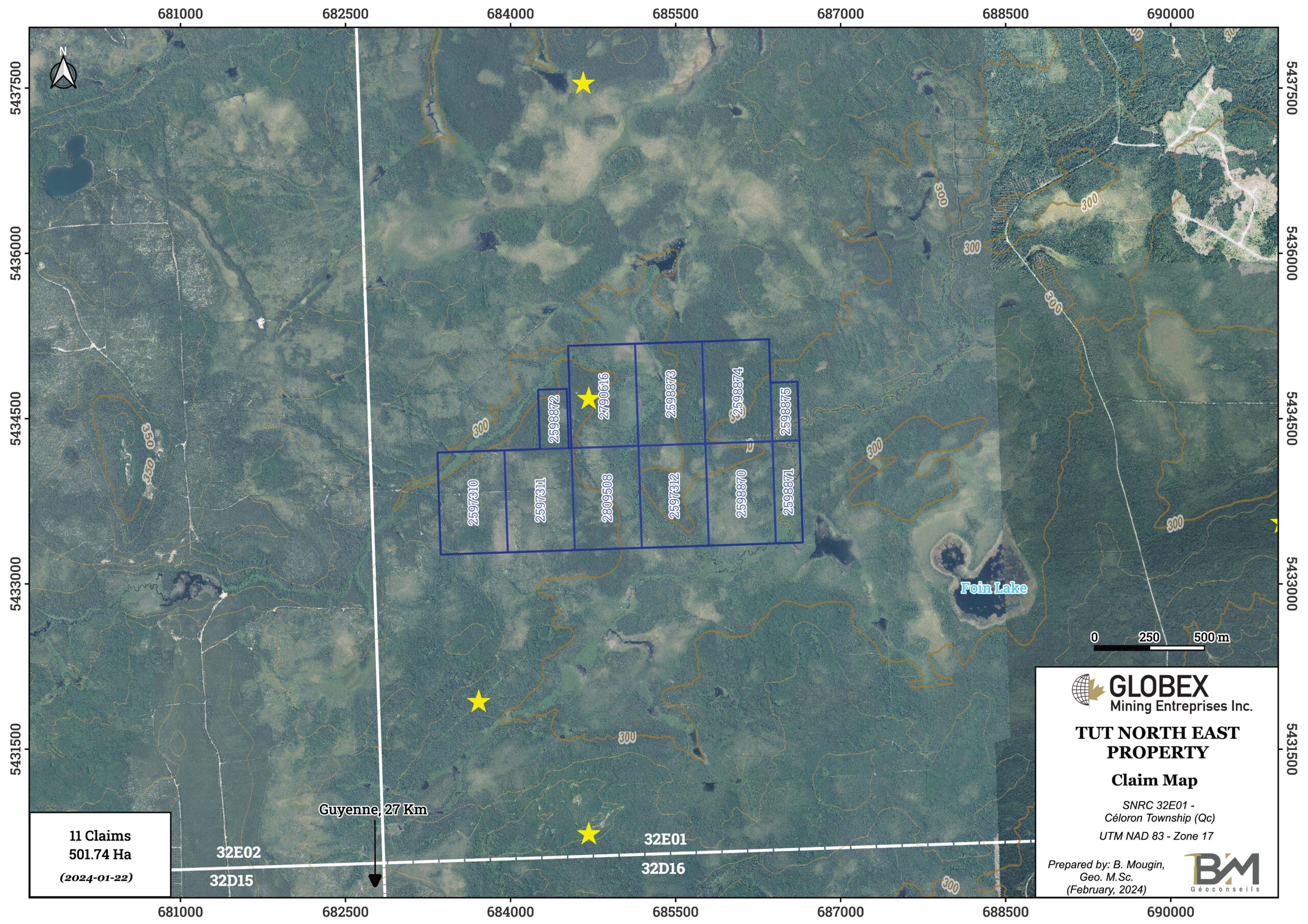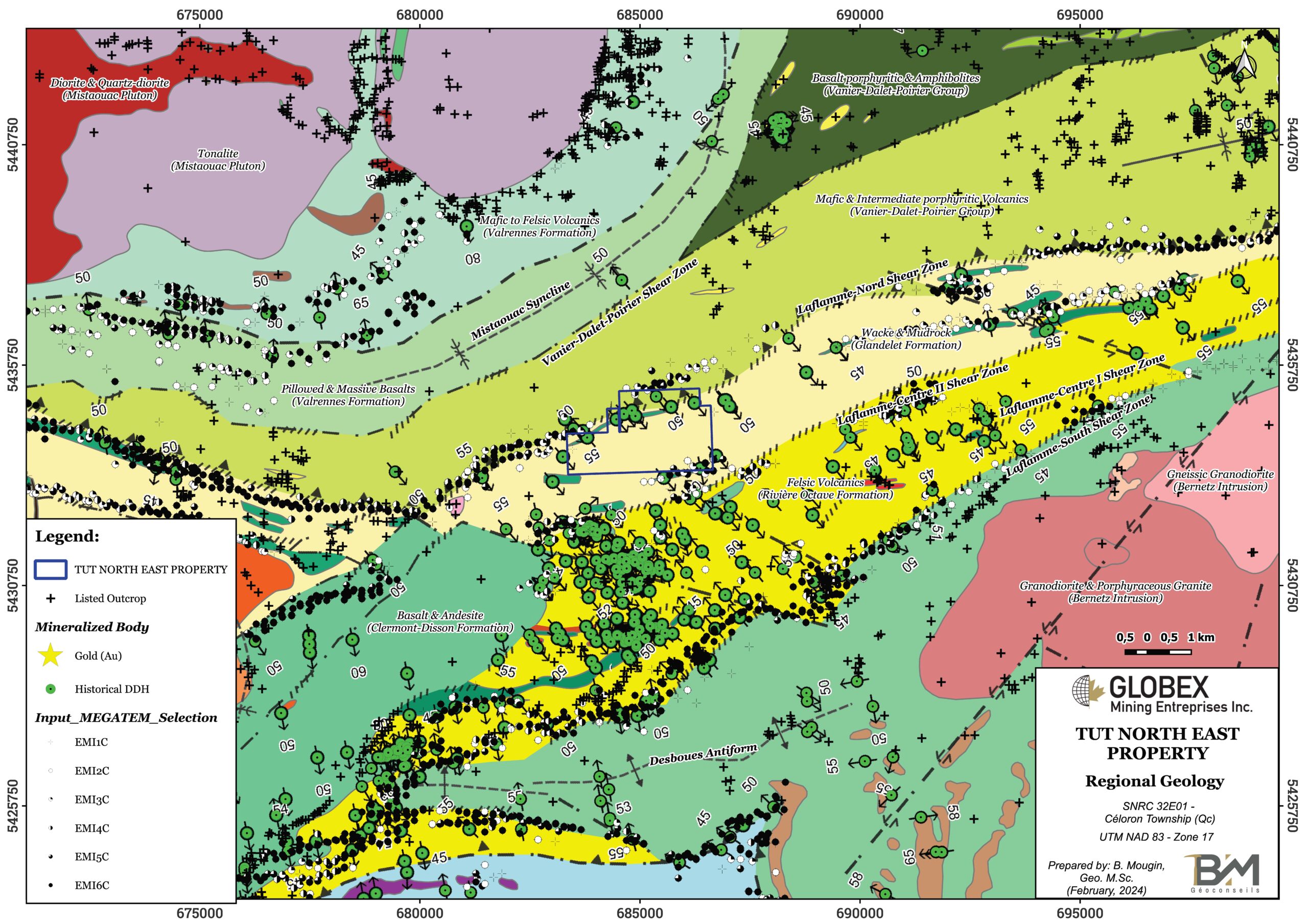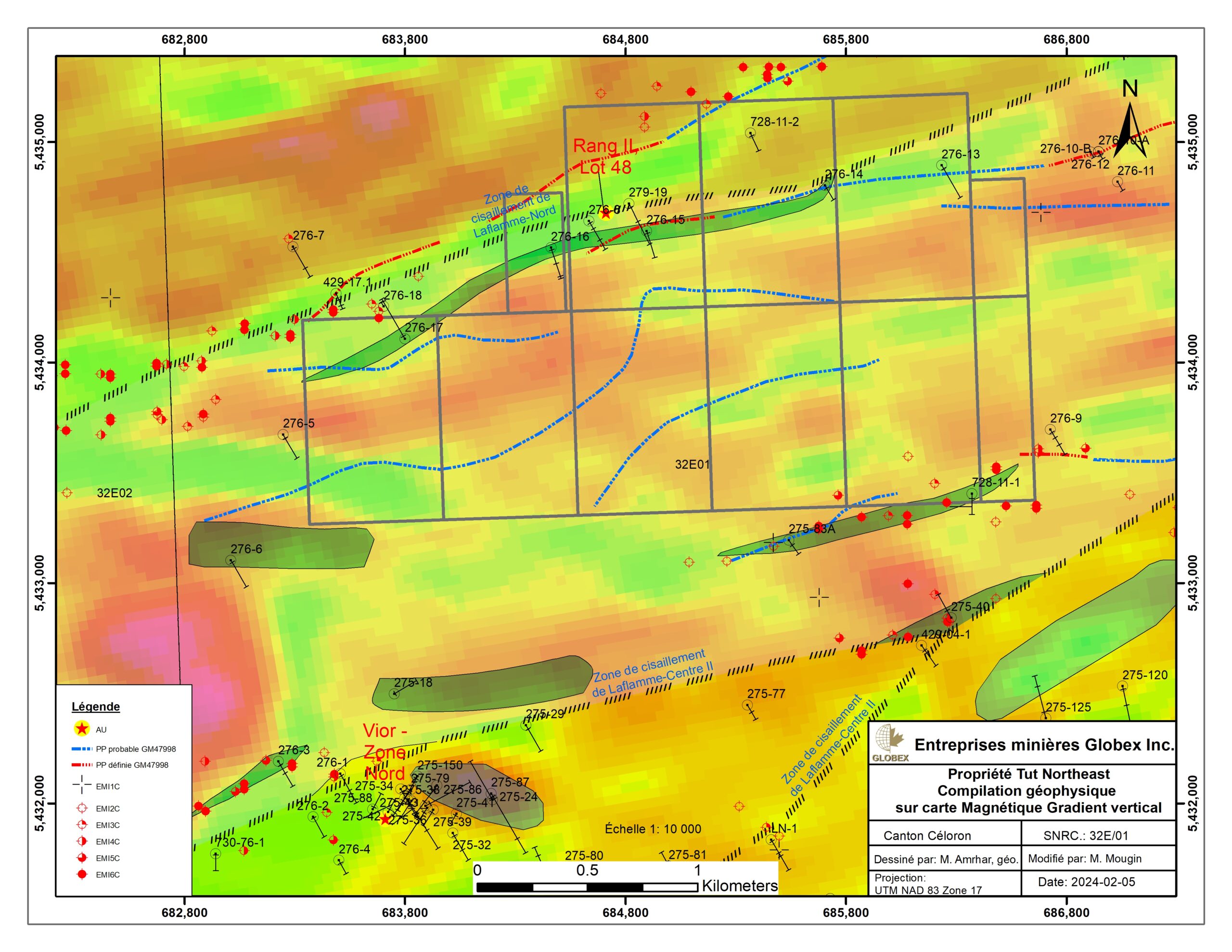Tut Northeast
Location, Access, Description
The Tut North-East property consists of 11 mining claims totalling 501.74 Ha in Céloron township (Qc, NTS 32E01). The claims are wholly owned by Globex and are not subject to any underlying royalties or third party interests. Towns of Amos and Rouyn-Noranda are respectively located 60km southeast and 100km southwest of the property, giving access to numerous contractors and providing workers with food and sleeping facilities.
One can easily access to the Tut North-East property driving from Rouyn-Noranda on Road 101 North to Poularies, then turning right on Road 390 East to Taschereau. Gravel roads then lead to the property for a total journey of approximately 2 hours. A network of gravel roads runs throughout the property allowing to navigate easily by VTT to every part of the property. Topography in the area is generally flat and swampy with elevations comprised between 290 and 300 meters above sea level and not much outcrops. The property is covered with boreal forest vegetation.
Geology and Mineralization
Regional Context
The Tut North-East property is located in the Northern Volcanic Zone of the Archean Abitibi Greenstone Belt, within the Superior Province of the Canadian Shield. Rocks of this area are characterized by the predominance of large plutonic masses like the Bernetz (<2695 ±1 Ma; MB2010-06) and Mistaouac (2726 ±2 Ma; Davis et al., 2000) Plutons. Between these intrusions are observed thick supracrustal sequences of mafic to felsic volcanics and sedimentary rocks metamorphosed to the greenschists to amphibolite grade near the large intrusions. These units include the formations of Valrennes (>2728 ±0.9 Ma), Clermont-Disson, Desboues, Rivière Octave (2726.3 ±2.4 Ma) and Glandelet (<2695Ma), as well as the groups of Vanier-Dalet-Poirier (2722 ±1 Ma), Quévillon (2716.4 ±1.1 Ma) and Chicobi (<2698 ±2.4 Ma). Lithological contacts and regional structures show concentrations of EM anomalies suggesting important sulphide content. At least four (4) deformation episodes have been recognized in this area (Daigneault et al., 2004). Both Mistaouac and Bernetz intrusions are considered as syntectonic ones. Quebec Vertical Gradient of Magnetic Field suggests two (2) dominant structural directions in the region of the property: NE-SW and ESE, the latter intersecting the first one.
Property Details
The property is located inside the Glandelet Formation which is essentially formed of turbiditic sedimentary rocks associated with mudstones and iron formations. Sedimentation is believed to be contemporaneous of that of the Chicobi Group (MB2010-06). The property is located between the Laflamme-Centre and Laflamme-North shear zones and hosts the “Rang II, Lot 48” gold showing discovered by drilling 276-8 which returned 2.35 g/t Au over 1.49m (GM47998). The mineralized section in that hole is composed of 2-4% disseminated pyrite in sheared felsic lapilli tuff, explaining an anomaly of induced polarization.
Mineralization
The region hosts numerous gold showings that follow the strikes of Laflamme-South, Laflamme-Centre and Laflamme-North shear zones. Most of the showings are of filonian type and associated with quartz veins injected within regional shear zones. Mineralization is composed of 1-40% auriferous pyrite which can be observed either disseminated in foliation and fractures, either in clusters or veinlets, or even semi-massive (Vior showings). The main alteration observed in hostrocks within mineralized zones of that area is sericite-silica-carbonate (ankerite) with local chloritization. Some late ESE faults served as drains for auriferous fluids and therefore represent good metallotects for remobilized gold enrichments.
History
The Questor Input Survey flew the property in 1972 (DP104, DP761). Regional mapping of that area was carried-out by MERN in early 80’s (ET82-01, DV83-11).
Between 1984 and 1990, Sigma Ltd. undertook several Magnetic, EM-VLF and IP surveys over the property (GM41992, GM42523). Numerous IP anomalies were identified, some of which were tested successfully by three (3) DDH programs totaling 2,682.46 metres (GM47998, GM49577). DDH 276-8 discovered the “Rang II, Lot 48” gold showing. DDH 276-15 (2.68 g/t Au over 2.3m) tested another IP anomaly and intersected the extension 200 metres to the east of the showing in a carbonatized shear zone containing 25% quartz-carbonate veins and up to 3% pyrite.
Resources and Potential
Induced polarization and EM-VLF surveys completed on the property by Sigma Mines Ltd. (1984) show there still are untested anomalies on the Tut North-East Property and it’s very probable these anomalies are caused by sulphide mineralization with possible gold content as it is the case on 276-8 and 276-15 holes. The Vertical Gradient of Magnetism highlights two (2) main orientations in that area: NE-SW concordant with the regional foliation and late ESE structures.
In 2013, a resource calculation was performed for the Sleeping Giant mine located 38km ENE from the property following in strike the Laflamme-North Shear Zone, using a cut-off grade of 6.5 g/t Au. The indicated and measured resources total 306,100t at 12.3 g/t Au (Measured: 2,000t at 6.9 g/t Au; Indicated: 304,100t at 12.4 g/t Au) and the inferred resources are 41,700t at 12.4 g/t Au, distributed across the 15 mineralized zones (DV2014-01).
The economic potential of the Tut North-East Property is evident regarding pas exploration works but still appears strongly underexplored. Very little follow-up was done on the historical geophysical anomalies and DDH gold intersections. It is therefore recommended to:
- Complete a NOVATEM airborne magnetic survey totaling approximately 149 linear km, following N-S lines, spaced 25m with E-O attachment lines spaced 250m, in order to better locate lithological contacts and structures where sulphides and gold seem to be mostly concentrated ;
- Carry-out new induced polarization surveying to refine the IP anomalies defined in 1984 by Sigma Mines Ltd. ;
- Undertake additional DDH to test every IP anomalies in that area as gold is strongly associated with pyrite mineralization.



